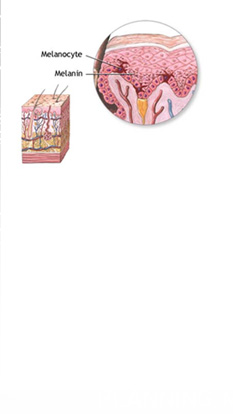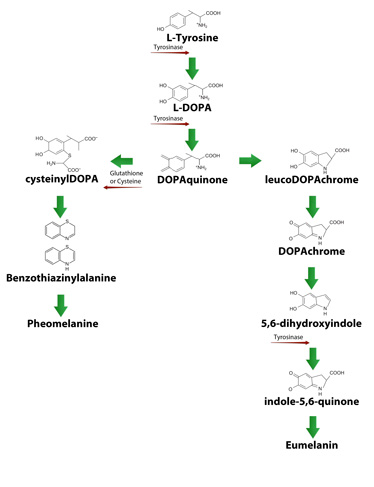







Upon exposure to UV radiation, DNA damage triggers cytokines, growth factors and other inflammatory factors to stimulate melanin production. Melanin forms in specialised cells called melanocytes. Melanocytes are especially abundant in the basal layer of the epidermis and underlying dermis and are responsible for the pigmentation of the skin. The melanocytes, by increasing the production of intracellular nitric oxide (NO), they trigger signal transduction cascades to initiate melanogenesis through a series of oxidative reactions involving the amino acid tyrosine in the presence of the enzyme tyrosinase. This leads to the production of melanin. Melanin granules synthesized in the melanocytes are then transferred from the cytoplasm of the melanocytes to the basal cytoplasm of the keratinocytes. In the human epidermis, melanocytes work in close harmony with their neighbouring cells such as keratinocytes via their dendrites. They thus form a protective covering in the inner layers of the epidermis, absorbing UV rays and inhibiting their penetration.
In the following diagram the process of melanin synthesis can be seen in more detail:

Melanin synthesis begins in the liver where phenylalanine is converted to tyrosine by the action of phenylalanine hydroxylase. The oxidation of L-Tyrosine to L-DOPA is then catalysed by the action of tyrosinase enzymes within the melanocyte's melanosome. In the next step L-DOPA is oxidized to DOPAquinone.
From DOPAquinone, the melanin synthesis pathways diverge to produce either eumelanin or pheomelanin.
Eumelanin
Firstly, DOPAquinone is converted to leucoDOPAchrome and then DOPAchrome through auto-oxidation, and subsequently in the presence of DOPAchrome tautomerase and dihydroxyindole-2-carboxylic acid oxidase, DOPAchrome is converted to 5,6-dihydroxyindole. Finally, the oxidation of 5,6-dihydroxyindole (DHI) to indole-5,6-quinone by tyrosinase leads to the formation of eumelanin (brown-black pigment).
Pheomelanin
In the presence of cysteine or glutathione, dopaquinone is converted to cysteinyl DOPA Subsequently, pheomelanin, a yellow-red pigment, is formed through the oxidative polymerization of cysteinyldopa via 1,4-benzothiazinylalanine intermediates.
>
>
MELANIN SYNTHESIS
Introduction
Melanin Syhthesis Pathways
